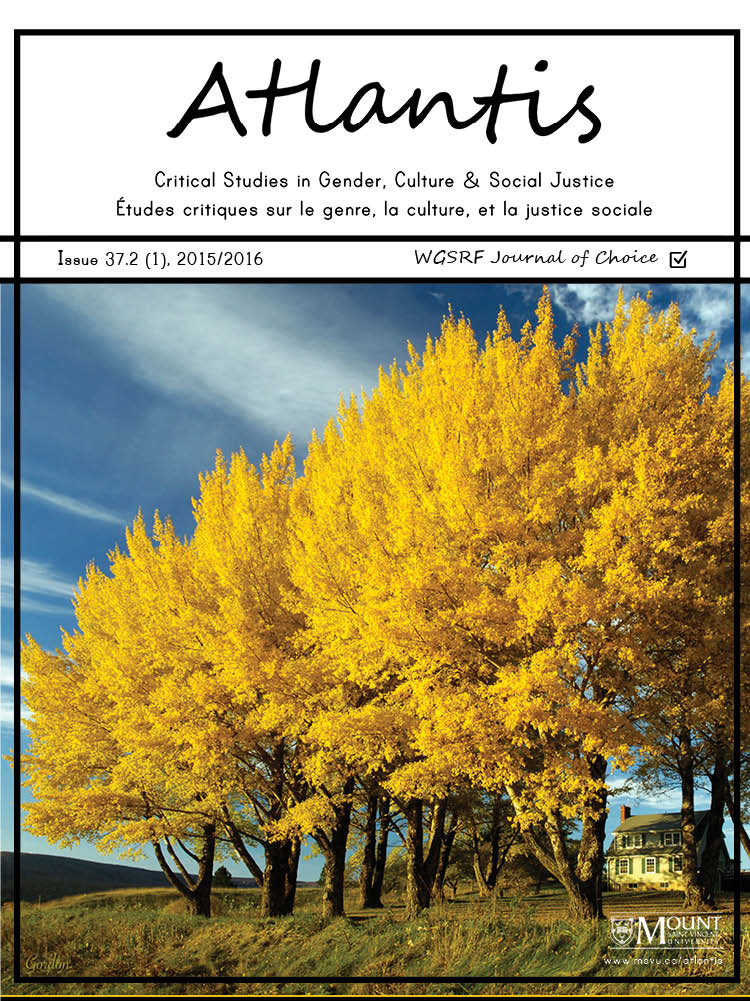Critical Perspectives on Canadian Anti-Trafficking Discourse and Policy
Résumé
Abstract
Références
Agustín, Laura. 2003. “Sex, Gender and Migrations: Facing up to Ambiguous Realities.” Soundings 23: 84-98.
Agustín, Laura. 2007. Sex at the Margins: Migration, Labour Markets and the Rescue Industry. London, U.K.: Zed Books.
Anderson, Bridget, and Rutvica Andrijasevic. 2008. “Sex Slaves and Citizens: The Politics of Anti-Trafficking.” Soundings 40: 135-145.
Bernstein, Elizabeth. 2007. “The Sexual Politics of the ‘New Abolitionism’.” differences 18 (5): 128-151.
De Shalit, Ann, Robert Heynen, and Emily van der Meulen. 2014. “Human Trafficking and Media Myths: Federal Funding, Communication Strategies, and Canadian Anti-Trafficking Programs.” Canadian Journal of Communication 39: 385-412.
Doezema, Jo. 2001. “Ouch!: Western Feminists’ ‘Wounded Attachment’ to the ‘Third World Prostitute’.” Feminist Review 67: 16-38.
Doezema, Jo. 2010. Sex Slaves and Discourse Masters: The Construction of Trafficking. London, UK: Zed Books.
Global Alliance Against Traffic in Women (GAATW). 2011. What’s the Cost of a Rumour? A Guide to Sorting Out the Myths and the Facts About Sporting Events and Trafficking. Vancouver, BC: Global Alliance Against Traffic in Women. http://www.gaatw.org/publications/WhatstheCostofaRumour.11.15.2011.pdf
Hunt, Sarah. 2013. “Decolonizing Sex Work: Developing an Intersectional Indigenous Approach.” In Selling Sex: Experience, Advocacy, and Research on Sex Work in Canada, edited by Emily van der Meulen, Elya M. Durisin, and Victoria Love, 82-100. Vancouver, BC: University of British Columbia Press.
Kempadoo, Kamala, with Jyoti Sanghera and Bandana Pattanaik, eds. 2005. Trafficking and Prostitution Reconsidered: New Perspectives on Migration, Sex Work, and Human Rights. Boulder, CO: Paradigm Publishers.
Lepp, Annalee. 2013. “Repeat Performance? Human Trafficking and the 2010 Vancouver Olympic and Paralympic Games.” In Selling Sex: Experience, Advocacy, and Research on Sex Work in Canada, edited by Emily van der Meulen, Elya M. Durisin, and Victoria Love, 251–268. Vancouver, BC: University of British Columbia Press.
Peters, Alicia. 2013. “‘Things that Involve Sex are Just Different’: US Anti-Trafficking Law and Policy on the Books, in Their Minds, and in Action.” Anthropological Quarterly 86 (1): 221-256.
Public Safety Canada. 2012. National Action Plan to Combat Human Trafficking – 2012-2013 Annual Report on Progress. Ottawa, ON: Public Safety Canada. http://www.publicsafety.gc.ca/cnt/rsrcs/pblctns/2013-ntnl-ctn-pln-cmbt-hmn/2013-ntnl-ctn-pln-cmbt-hmn-eng.pdf.
Roots, Katrin. 2013. “Trafficking or Pimping? An Analysis of Canada’s Human Trafficking Legislation and its Implications.” Canadian Journal of Law and Society 28 (1): 21-41.
Sharma, Nandita. 2005. “Anti-Trafficking Rhetoric and the Making of a Global Apartheid.” NWSA Journal 17 (3): 88-111.
Small, Deborah, George Loewenstein, and Paul Slovic. 2007. “Sympathy and Callousness: The Impact of Deliberative Thought on Donations to Identifiable and Statistical Victims.” Organizational Behavior and Human Decision Processes 102: 143–153.
Soderlund, Gretchen. 2005. “Running from the Rescuers: New U.S. Crusades against Sex Trafficking and the Rhetoric of Abolition.” NWSA Journal 17 (3): 64-87.
Stanley, Brandy. 2009. “Sensationalism and its Detrimental Effect on the Anti-Human Trafficking Movement: A Call to a Critical Examination of ‘Abolitionist’ Rhetoric.” A partial completion of Contemporary Slavery and Human Trafficking. Josef Korbel School of International Studies. University of Denver.
Weitzer, Ronald. 2012. “Sex Trafficking and the Sex Industry: The Need for Evidence-Based Theory and Legislation.” The Journal of Criminal Law and Criminology 101 (4): 1337-1369.
Téléchargements
Publié
Numéro
Rubrique
Licence
© Atlantis: Études critiques sur le genre, la culture, et la justice 2016

Cette œuvre est sous licence Creative Commons Attribution 4.0 International.
Les auteurs qui publient dans cette revue acceptent les conditions suivantes:
1. Les auteurs conservent les droits d’auteur et accordent le droit de première publication à la revue. L’œuvre est simultanément sous licence internationale Creative Commons Attribution 4.0 qui permet à d’autres personnes de la partager en citant dans les remerciements l’auteur de l’œuvre et sa publication initiale dans cette revue.
2. Les auteurs savent que les articles publiés dans Atlantis sont indexés et disponibles par le biais de divers outils de recherche universitaires et professionnels, y compris, entre autres, Erudit.
3. Les auteurs peuvent conclure des ententes contractuelles supplémentaires et distinctes pour la distribution non exclusive de la version de l’article publiée par la revue (c’est-à-dire, l’afficher dans un dépôt institutionnel ou la publier dans un livre), en signalant qu’elle a été initialement publiée dans cette revue.
4. Les auteurs sont autorisés et encouragés à prépublier leur œuvre, c’est-à-dire à la publier en ligne (dans un dépôt institutionnel ou sur leur site Web, par exemple) avant et pendant le processus de soumission. Cela peut conduire à des échanges productifs, ainsi qu’à ce que le travail publié soit cité plus tôt et plus souvent. Renseignez-vous davantage ici sur la prépublication.







